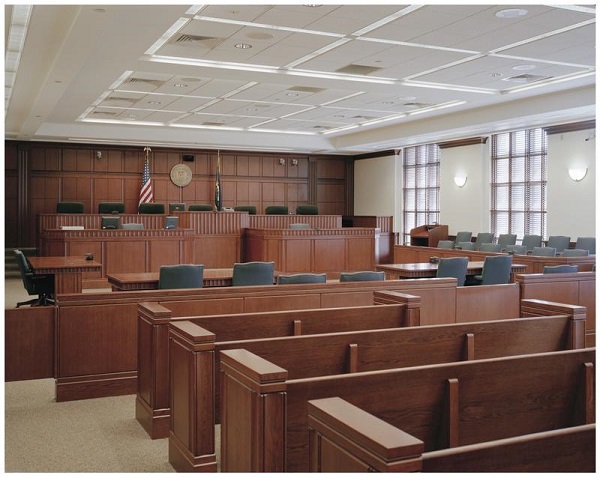Spectator Seating
 |
Courtroom in Lexington-Fayette County, Kentucky Courthouse Complex |
As a general rule, trials must be open and public. Persons who wish to view trials and hearings, whether members of the press or ordinary citizens, have a right to both see and hear the proceedings. Seating for spectators in notorious criminal trials usually overwhelms even the largest courtrooms and large multi-judge courts may want to plan one or two courtrooms to accommodate additional public seating. These courtrooms may also be designed for high security trials and equipped with audiovisual and news media features not normally required for most trials.
Public seating should remain at floor level. This allows access by disabled persons and adds prominence to the litigation area and judge's bench. The difference in elevation from the bench to the spectator-seating area promotes the judge's visual control of the courtroom.
The size of the spectator-seating area in most courtrooms is often determined by the number of empanelled jurors. For voir dire, the prospective juror panel typically is between 24 and 60, depending upon the number of alternates and the number of challenges allowed by the court. Seating requirements should satisfy this number of jurors in addition to witnesses and spectators. A good planning average would be 9 to 12 square feet per person, including circulation. In large courtrooms, a standard of 9 square feet per person should be used. In smaller courtrooms, the 12 sf figure should be used.
One person's seating allowance should be calculated on the basis of 3 square feet (2 x 18 inches). Rows that can hold eight or more people require two exit aisles to meet fire code specifications. There should be three feet between the first row and the railing of the well area to provide sufficient physical and sound separation between spectators and trial participants. This passageway may also serve as an exit to the central aisle, and care should be given to meeting local code restrictions.
The width of aisles in the spectator seating area should be in accordance with local and state building and life safety code requirements. Generally, side aisles should be at least three feet wide, the center aisle should be five feet wide, and there should be 39 inches between rows.
The lighting should be subdued but sufficient so that the judge and bailiff can clearly see everyone in the spectator area. The floor should be carpeted and the surrounding walls should be acoustically treated.
Public seating within the courtroom should include accessible wheelchair spaces; the number of accessible wheelchair spaces, and their location and dispersal should comply with the ADA requirements for assembly areas. In addition, where the seating capacity exceeds 50 and is located on one level that is not tiered or sloped, wheelchair spaces shall be provided in more than one seating row.
A permanently installed assistive listening system is required in fifty percent (50%) of all courtrooms, but not less than one of each type of courtroom provided in a building; a portable assistive listening system may be used in those courtrooms which do not contain a permanent system. Receivers for this system should be provided for a minimum of four percent (4%) of the room occupant load, but not less than two. The system should accommodate the public, as well as attorneys, jurors, judges, witnesses, court clerks, and court reporters. A best practice would be to equip all courtrooms with assistive listening systems.
Public entry into the courtroom should be through a vestibule of approximately 70 to 90 square feet for noise control and security. The inner set of doors should have sufficient glass panels to permit visual identification of courtroom activities and participants without entering the courtroom.
For reasons of security, a single monitored public entrance is preferred. In traditional courtrooms, this entrance should be along the rear wall of the courtroom on the same axis as the judge's bench. In corner-orientation courtrooms, the entrance should be off-angle from the judge's bench and not along the same side of the courtroom.
The spectator-seating area should be directly accessible from the public circulation corridors.
Additional security may be provided by placing metal detectors at the entrance to the courtroom during high profile or high security cases. It is also desirable to separate opposing parties seated in the courtroom.
Seating may be either bench-type or theatre-type. Movable or stacking chairs should not be provided. Bench seating with comfortable padding is preferred over theatre seats because benches can accommodate more people within the same area. Bench seating is also comparatively easy to maintain, shows wear less quickly, and offers a dignified appearance. The jury box may be converted to bench-type spectator seating in non-jury courtrooms in order to increase the seating capacity. When the jurisdiction requires additional jury courtrooms, the seating can be removed and replaced with standard juror-type seating.
A large screen display monitor should be available for the public to view evidence presentations and remote witness testimony. It should be positioned so that it can be viewed by persons in the public seating area or gallery.
Courtrooms over 800 SF generally need audio amplification to permit public spectators to hear clearly and understand the participants.